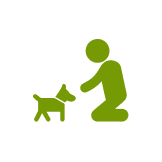In 24 cities

Is Your Dog Pushing Too Hard? Identifying Signs of Excessive High-Intensity Activity
|
|
Time to read 2 min
Enter pincode
Please enter a valid pincode Enter the pincode to check delivery date
Enter the pincode to check delivery date


LOWEST EVER PRICES
BIGGEST PET CARE SALE
LOWEST EVER PRICES
BIGGEST PET CARE SALE


LOWEST EVER PRICES
BIGGEST PET CARE SALE
LOWEST EVER PRICES
BIGGEST PET CARE SALE
100% Authentic

Easy return policy

Help us ensure a smooth delivery
SIZE GUIDE
Written by: Dr. Shantanu Kalambi
|
|
Time to read 2 min
As devoted veterinarians, we are dedicated to ensuring that our beloved canine companions lead healthy and fulfilling lives. Today, we want to shine a spotlight on a critical issue that pet parents must be aware of: identifying signs of excessive high-intensity activity in dogs. Let's delve into the key indicators that your furry friend may be pushing themselves too hard during exercise.
If your dog seems unusually tired or lethargic after physical activity, it's a red flag that they may be overexerting themselves. Pay attention to signs of prolonged fatigue, such as excessive panting, reluctance to move, or seeking out rest immediately after exercise.
Keep a close eye on your dog for signs of muscle strain, particularly after vigorous exercise sessions. Watch for limping, reluctance to bear weight on certain limbs, stiffness, or visible signs of discomfort when moving. These could indicate that your dog has pushed their muscles beyond their limits.
Dogs engaging in excessive high-intensity activity are at increased risk of joint injuries, which can have serious consequences for their mobility and overall well-being. Look out for signs of lameness, swelling, or reluctance to bear weight on affected limbs, as these may indicate underlying joint issues.
In addition to the primary signs mentioned above, it's crucial to be vigilant for other symptoms that could indicate your dog is experiencing excessive strain during exercise. These include:
Purple Mucus Membranes: Check your dog's mucus membranes, such as their gums and tongue, for a purple or bluish tint. This could signal a lack of oxygen due to overexertion or overheating.
Signs of Exercise Intolerance/Overheating: Watch for signs of overheating, such as excessive panting, drooling, or seeking out cool surfaces. Exercise intolerance may manifest as an inability to continue physical activity despite previous endurance levels.
If you notice any of these signs in your dog, it's essential to take prompt action to address the issue and prevent further harm. Here's what you can do:
Give Your Dog Rest: Allow your dog ample time to rest and recover from strenuous exercise. Limit their activity level until they show signs of improvement.
Monitor Closely: Keep a close eye on your dog's condition and behavior, noting any changes or worsening symptoms. If concerns persist, seek veterinary advice promptly.
Adjust Exercise Routine: Modify your dog's exercise routine to reduce intensity and duration, ensuring it aligns with their individual needs and capabilities.
By recognizing the signs of excessive high-intensity activity and taking appropriate action, you can help safeguard your dog's health and well-being. Remember, attentive observation and proactive intervention are key to ensuring that your furry companion enjoys a long, happy, and active life.



In 24 cities

Happy pet parents

For every new member

Exclusive
2 item in cart
₹10,360




